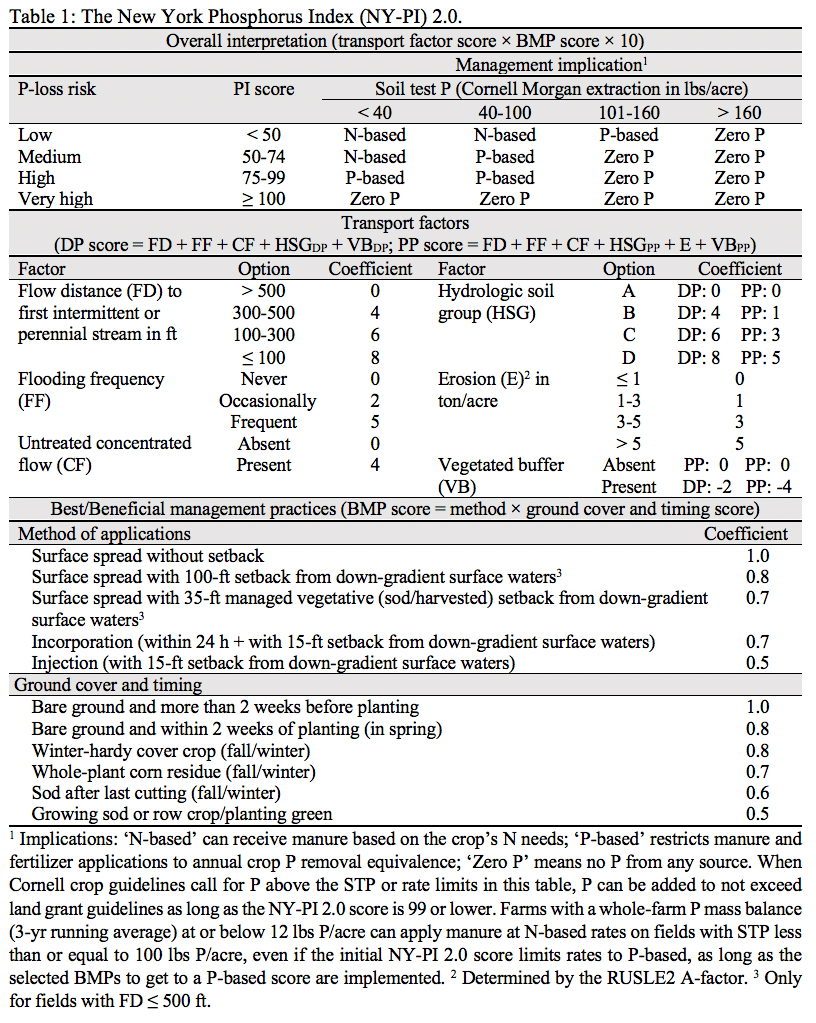S. Sunoja, Quirine M. Ketteringsa, Joe Lawrenceb, and Greg Godwina
a Nutrient Management Spear Program, Department of Animal Science, Cornell University, Ithaca, NY 14853, b PRODAIRY, Department of Animal Science, Cornell University, Ithaca, NY 14853
Introduction
Most land-grant university corn nitrogen (N) guidelines recommend the use of a small quantity of starter at planting followed by sidedressing when corn is at V6, when N requirements exceed appropriate starter rates. This approach aims to supply a small amount of N for the first weeks of growth after emergence when the plants need only a small amount of N, followed by application of a larger amount of readily available N at V6, prior to the start of the rapid growth curve of a corn plant. However, sometimes getting into the field in time for sidedressing at V6 can be challenge. Farmers and crop advisors have asked what to expect when sidedressing is delayed beyond V6. If equipment is available to apply N to already tall corn plants, would it still benefit the crop? The past four years, we conducted trials to determine what happens with corn yield and N use efficiency when sidedressing is delayed beyond V6.
Timing of N sidedress application and yield data
A sidedress experiment was conducted at the Musgrave Research Farm in Aurora, NY from 2017 through 2020. The soil type is classified as Lima silt loam with a pH of 7.8. Corn was planted on May 20 (2017), May 14 (2018), May 27 (2019), and May 21 (2020) at a rate of 31,000 to 35,000 seeds per acre. The seed varieties were Pioneer P0157 in 2017 and 2018, P9188AMXT in 2019, and P8989AM in 2020. Each year, starter N was applied at a rate of 30 lbs N per acre. The six treatments included zero N (NoN), N rich (NRich; 300 lbs N/acre at planting), and sidedress applications (180 lbs N per acre applied) at V4, V6, V8, and V10. Corn was harvest for grain each year.
Results
Effect of timing of N sidedress application on yield
The NRich treatments yielded 202, 136, 170 and 161 bu per acre in 2017, 2018, 2019, and 2020, respectively, averaging 168 bu per acre across the four years. The large year to year differences reflected, among others, weather patterns; 2017 and 2019 received 10.4 and 9.9 inches of rainfall in May-June, while in 2018 and 2020 rainfall amounted to 6.0 and 5.5 inches, respectively.
Independent of the year of the experiment, the NoN treatment consistently produced the lowest yield. On average, across years, the NoN treatment averaged 45% of the yield obtained in the NRich treatments (Fig. 1). Not sidedressing reduced yield by, on average, 90 bu per acre, clearly indicating the need for additional N for this location.
Sidedressing at 180 lbs of N per acre at V4 and V6 resulted in yields that averaged 97% of the yield of the NRich treatment (Fig 1). Delaying sidedressing to V8 and V10 significantly reduced the yield (Fig. 1) to 95% (V8) and 87% (V10) of the yield that was obtained with the Nrich treatment and 96% (V8) and 89% (V10) of what was obtained with N application at V6. In general, yield declined the longer sidedressing was delayed beyond V6.
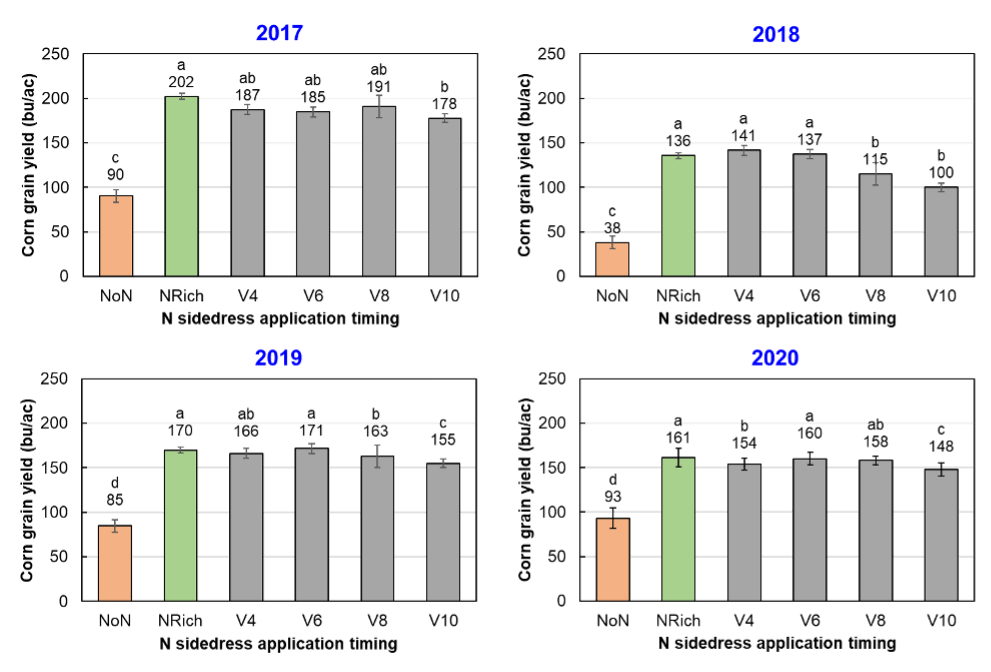
Nitrogen Uptake Efficiency
Sidedressing at 60% of the NRich rate can lead to the question: “Could yields have been higher for the sidedress treatments if more N had been applied?” The lack of a yield hit with early sidedress application compared to the Nrich treatment suggests the answer is no but we can also look at N balances for each of the treatments to investigate this. The ratio of N uptake to N supply (fertilizer N and soil N) shows that the crop took up about 70% of N supply when no N was applied beyond the starter (NoN treatment) and 44, 44, 42, and 39% for sidedressing at V4, V6, V8, and V10, respectively. The lowest uptake efficiency was for the NRich treatment (only 31%), signaling that (1) there was a considerably over-application of N in the NRich treatments each year, and (2) it was very unlikely that N supply limited yield at the various sidedress rates.

Conclusions and Implications
Sidedressing at V4 and V6 growth stages produced the same yield as obtained in the NRich treatment. Delaying the sidedress application to V8 and V10 resulted in reduced yield compared to what was obtained with sidedressing the same amount of N at V4 and V6. However, yields with sidedressing at V8 and V10 still produced significantly higher yields than obtained in the NoN treatment. The N balance evaluations showed that N use efficiency declined with sidedressing beyond V6, primarily due to the yield hit taken when sidedressing was delayed (and sidedress N was needed in the first place). Based on these results, we conclude that if additional N beyond a small starter is needed for optimal yield, it is recommended to sidedress earlier rather than later in the season.
Acknowledgements
 This research was funded with federal formula funds. We thank the Paul Stachowski, farm manager of the Musgrave Research Farm at Aurora, NY, for help with field management. We also thank the many NMSP team members for help with harvest and sample processing over the years. For questions about these results, contact Quirine M. Ketterings at 607-255-3061 or qmk2@cornell.edu, and/or visit the Cornell Nutrient Management Spear Program website at: http://nmsp.cals.cornell.edu/.
This research was funded with federal formula funds. We thank the Paul Stachowski, farm manager of the Musgrave Research Farm at Aurora, NY, for help with field management. We also thank the many NMSP team members for help with harvest and sample processing over the years. For questions about these results, contact Quirine M. Ketterings at 607-255-3061 or qmk2@cornell.edu, and/or visit the Cornell Nutrient Management Spear Program website at: http://nmsp.cals.cornell.edu/.
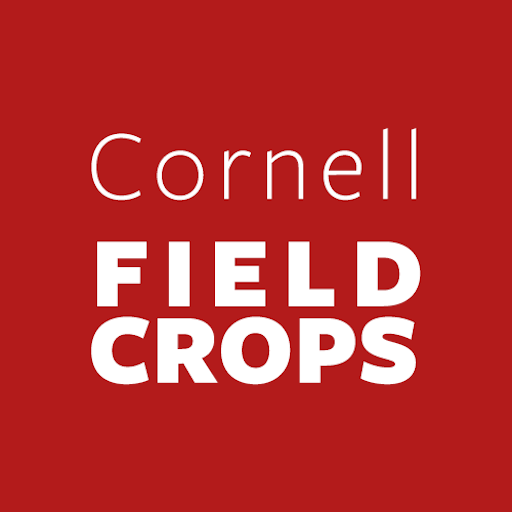

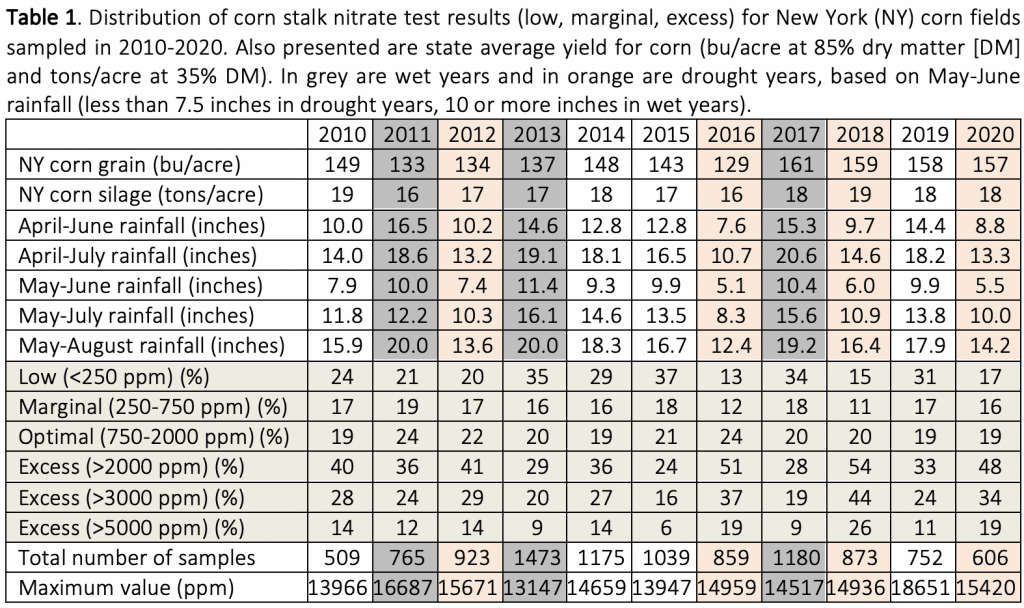
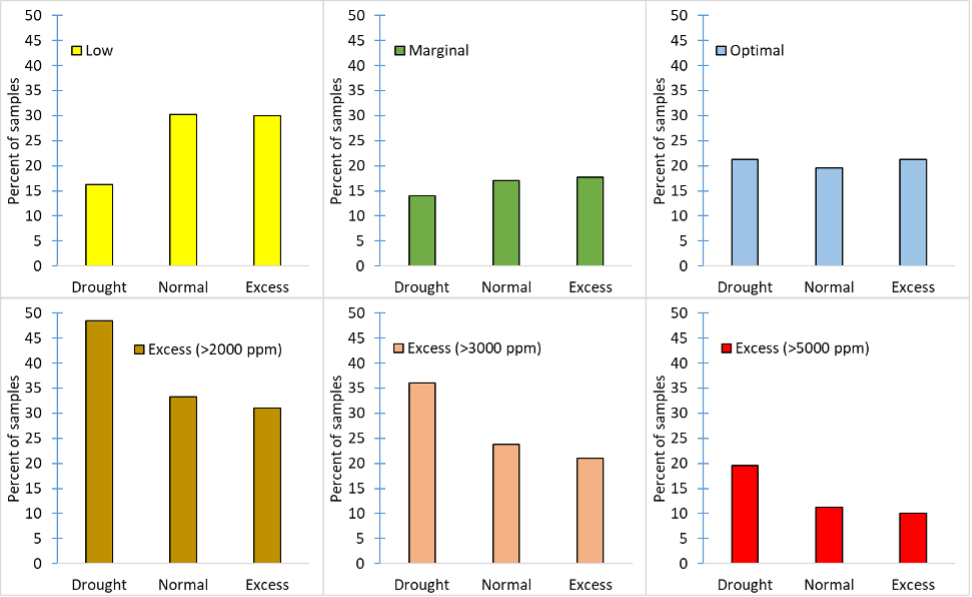


![Plant density and pre-sidedress nitrate test (PSNT) at V5, and corn stalk nitrate test (CSNT), silage yield [35% dry matter (DM)], crude protein (CP), and acid and neutral detergent fiber (ADF, NDF).](https://blogs.cornell.edu/whatscroppingup/files/2021/02/Conservation-tillage-Table-1-1024x457.png)




